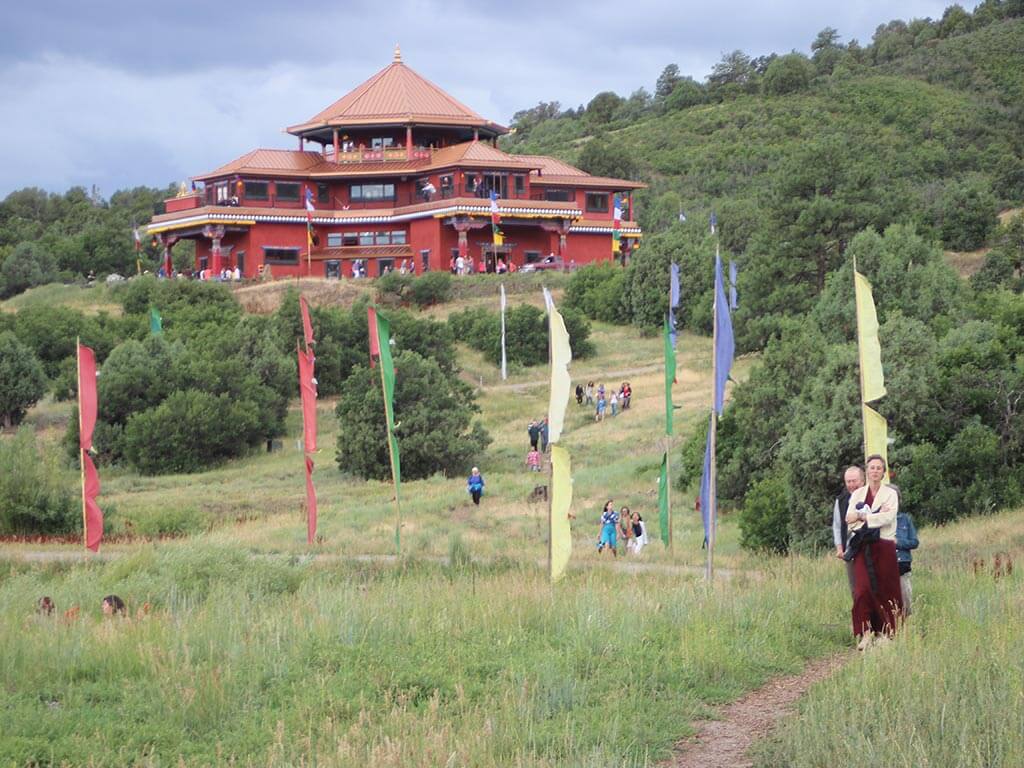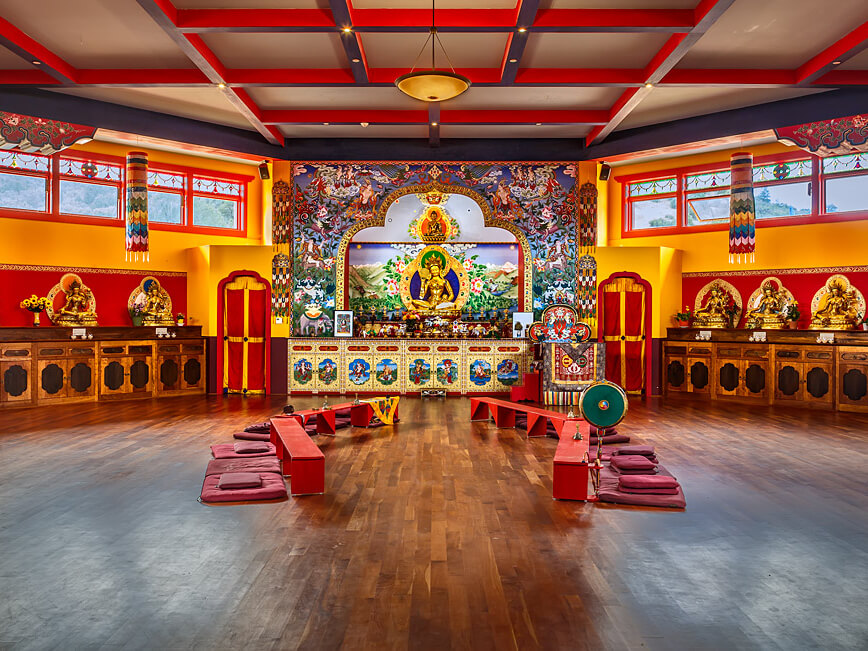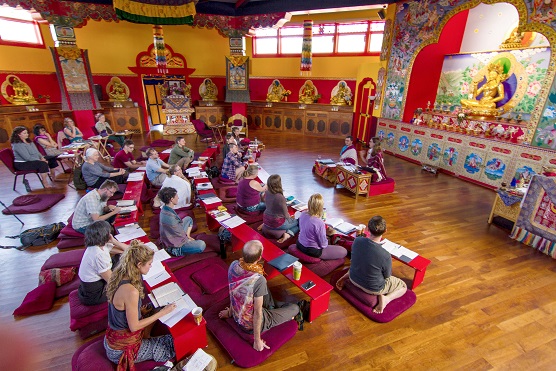Maddie Schuyler
The Tara Mandala Buddhist Retreat Center—located on 700 acres in Pagosa Springs, Colorado—is the center of an international Buddhist community that has over 40 groups involved around the world. Founded and led by Lama Tsultrim Allione, the Tara Mandala community follows Mahayana Buddhist teachings and meditation practices and seeks to provide a platform for individuals to pursue their own Buddhist studies and ways of life.

Tara Mandala was founded by Lama Tsultrim Allione and her husband David Petit in 1993. Lama Tsultrim had an extensive background in Buddhist practice previously. Lama Tsultrim—born Joan Rousmanière Ewing—traveled to Nepal and India from her New England home in her late teenage years and began to study Tibetan Buddhism. In 1970, when she was 22 years old, Lama Tsultrim was ordained as a Tibetan Buddhist nun, making her the first American to do so. Later on, she disrobed and had three children before marrying David. After Lama Tslutrim’s children had grown up, she and David moved to Pagosa Springs, Colorado together, where they founded Tara Mandala.
Lama Tsultrim had a vision for a western retreat center for people to practice meditation the way it had been practiced in Tibet, as well as a place for exploring the crossover between Buddhism and Western psychology. In the summer of 1994, Lama Tsultrim and David moved to the rolling hills and forests of southwestern Colorado with a group of their supporters. There, they began holding retreats in yurts or large tents for around ten years before they built permanent buildings and retreat cabins. At this point they started to host visiting Buddhist teachers at the retreat. In 1999, a stupa was built and consecrated at the retreat, and was dedicated to the great Dzogchen master Nyala Pema Duddul. They then added three new buildings in the early 2000s: the Community Building, the Prajna Residence Hall, and the Trikaya Tara Temple. This was all made possible through donations from supporters, and the Tara Mandala retreat center was completed without debt. The community continues to be funded by donations as well as the fees for some of their programs.
The Trikaya Tara Temple was designed based on a dream Lama Tsultrim had on the night of the Buddha’s birthday during a year-long solitary retreat. The third and top floor of the temple represents Dharmakaya, or “mind and pure awareness”. The second floor,—where there are offices and guest rooms for visiting teachers, a library, and space for archives—represents Sambhogakaya, or “sacred speech and the luminous radiance of pure form”. The ground floor is where the main temple is found, including a circumambulation corridor. This floor represents Nirmanakaya, or the physical embodiment of enlightened energy in our world. The shrine on the ground floor holds the temple’s 21 Tara statues from the Longchen Nyingtik tradition and the central figure, Machig Labdron. Machig Labdron was a female Tantric Buddhist teacher from the 11th century, and her teachings are the origin of the lineage of practice that is held at Tara Mandala. Lama Tsultrim had a vision of Machig once while practicing and was thus inspired to focus her teachings on Machig Labdron’s lineage.

The Tara Mandala website notes that “the Mandala of Tara is a symbolic template for the awakening of the compassionate heart through the manifestation of Tara, the female Buddha of compassion”. The Tara Mandala community aims to assist people on a path to realization rooted in the lineage of Machig Labdron. The relevance of the sacred feminine in both the female Buddha Tara and the lineage of Machig Labdron are reflected in Lama Tsultrim’s values and mission for the Tara Mandala community. Lama Tsultrim explains that “…the second purpose of Tara Mandala is to be a temenos for the emergence of the sacred feminine, through the lens of Vajrayana, leading to the balance of genuine partnership between the masculine and feminine in our world,”. Lama Tsultrim based her signature teachings and practices on “Feeding Your Demons” on Machig Labdron’s Chӧd lineage, in which one focuses on cultivating an understanding and compassion for one’s inner demons rather than struggling and fighting against them. Lama Tsultrim also draws inspiration from the teachings of Dzog Chen. Dzog Chen is a Mahayana Buddhist practice found in Tibet in the Nyingma, Bon, and Kagyu traditions, and involves extensive meditation practice to access one’s own pure awareness (Berzin).
The Tara Mandala community offers several different programs for people to get involved in Vajrayana Buddhist teachings through a meditation practice path and study of ancient Buddhist wisdom woven with aspects of Western psychology. They provide the option for online programs that can be self-paced or real-time with Zoom sessions. Tara Mandala offers several different types of programs or retreats in person at the retreat center in Colorado. This could take the form of a multi-day residential group retreat, a personal solitary retreat, a practitioner in residence program, or the “Living Dharma” program.
In the Living Dharma program, individuals have a daily schedule to pursue their own growth while living with a community of practitioners also dedicated to studying Buddha-Dharma. With a focus on Tibetan Buddhism, weekly classes teach Buddhist philosophy, history, and meditation. Participants start each day with a morning meditation and participate in service activities, then in the afternoon partake in teachings and studies, group discussions, and practices before having time for personal study and practice in the late evening after dinner. The Tara Mandala also offers pilgrimages in different areas of the world on occasion as an opportunity for community members to deepen their practice and gain merit.

Tara Mandala also seeks to provide the opportunity for people to connect in person even if they can’t travel to the retreat center to participate. Tara Mandala has organized over 40 sanghas in nine different countries worldwide. These sanghas meet regularly either in person or over Zoom, with apprentice teachers appointed by Lama Tsultrim to facilitate engagement of the members in their studies and practice.
The Tara Mandala community hopes to continue to maintain their strong and far-reaching community as well as welcome others to immerse themselves in their study of Buddhist practice and tradition at their Colorado retreat center that they hope will continue to flourish for generations to come.
Unless otherwise noted, all information and images are sourced from the Tara Mandala website.
Sources: